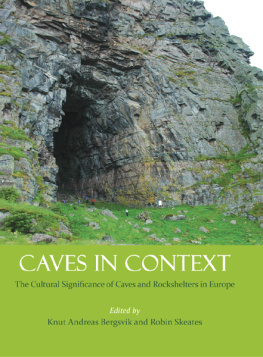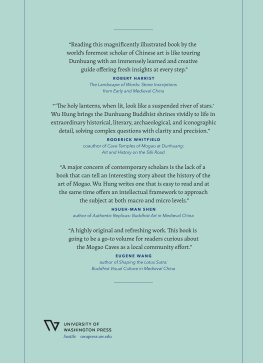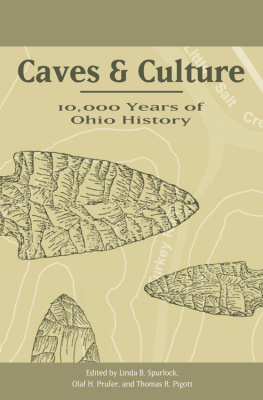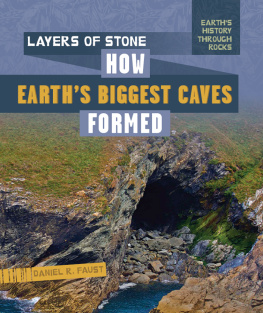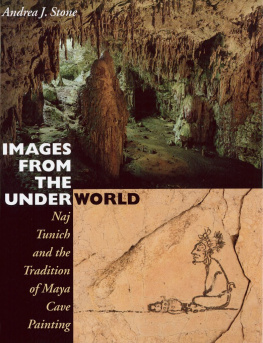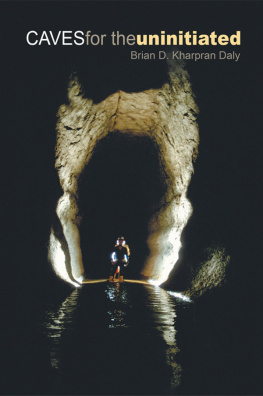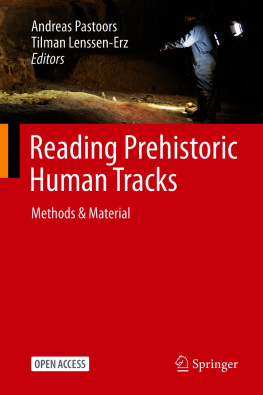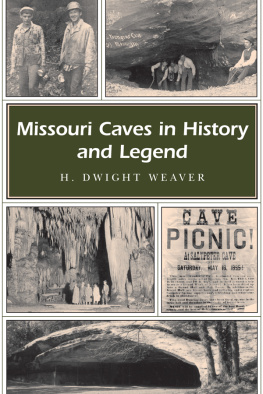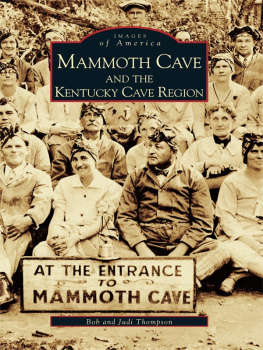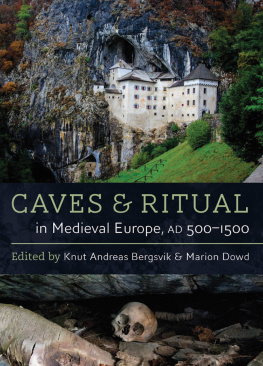
Published by
Oxbow Books, Oxford, UK
Oxbow Books and the authors, 2012
HARDBACK ISBN 978-1-84217-474-6
EPUB ISBN: 9781842179451
MOBI ISBN: 9781842179468
PDF ISBN: 9781842179475
A CIP record for this book is available from the British Library
This book is available direct from:
Oxbow Books, Oxford, UK
(Phone: 01865-241249; Fax: 01865-794449)
and
The David Brown Book Company
PO Box 511, Oakville, CT 06779, USA
(Phone: 860-945-9329; Fax: 860-945-9468)
or from our website
www.oxbowbooks.com
Library of Congress Cataloging-in-Publication Data
Caves in context : the cultural signifi cance of caves and rockshelters in Europe / edited by Knut Andreas
Bergsvik and Robin Skeates.
p. cm.
Includes bibliographical references.
ISBN 978-1-84217-474-6
1. Caves--Europe--History. I. Bergsvik, Knut Andreas. II. Skeates, Robin.
GB608.42.C34 2012
551.447094--dc23
2012008862
Front cover: Kirkehelleren at Trna, Norway. Photo:Knut Andreas Bergsvik
Back cover: inside the cave La Garma at Cantabria, Spain. Photo: Pablo Arias
Printed in Great Britain by
Short Run Press
Exeter
Contents
Knut Andreas Bergsvik and Robin Skeates
T HE B RITISH I SLES A ND S CANDINAVIA
Clive Bonsall, Catriona Pickard and Graham A. Ritchie
Knut Andreas Bergsvik and Ingebjrg Storvik
Anne Haug
Hein Bjartmann Bjerck
I BERIA A ND F RANCE
Nuno Bicho, Joo Cascalheira and Joo Marreiros
Javier Ordoo
Pablo Arias and Roberto Ontan
Estella Weiss-Krejci
Sbastien Manem
T HE C ENTRAL M EDITERRANEAN
Keith Buhagiar
Robin Skeates
Giusi Gradoli and Terence Meaden
Dimitrij Mleku
C ENTRAL A ND E ASTERN E UROPE
Jrg Orschiedt
Galina Levkovskaya, Vasiliy Lyubin and Elena Belyaeva
Valery A. Manko
Contributors
P ABLO A RIAS
Instituto Internacional de Investigaciones Prehistricas de Cantabria
(Unidad Asociada al CSIC)
Edificio Interfacultativo de la Universidad de Cantabria
Av. de Los Castros s/n
39005 Santander
Spain
E LENA B ELYAEVA
Russian Academy of Sciences
Institute of History of Material Culture
Dvortsovaya nab., 18
St.-Petersburg
191186 Russia
K NUT A NDREAS B ERGSVIK
University of Bergen
Department of Archaeology, history, Cultural Studies
and Religion
P.O. Box 7805
5020 Bergen
Norway
N UNO B ICHO
FCHS University of Algarve
Campus de Gambelas
8005-139 Faro
Portugal
H EIN B JARTMANN B JERCK
Norwegian University of Science and Technology (NTNU)
Museum of Natural History and Archaeology
NO-7491 Trondheim
Norway
C LIVE B ONSALL
University of Edinburgh
School of History, Classics, and Archaeology
Old High School
Infirmary Street
Edinburgh EH1 1LT
United Kingdom
K EITH B UHAGIAR
University of Malta,
Department of Classics and Archaeology
Msida MSD 2080
Malta
J OO C ASCALHEIRA
FCHS University of Algarve
Campus de Gambelas
8005-139 Faro
Portugal
J AVIER O RDOO D AUBAGNA
Department of Geography, Prehistory and Archaeology
University of Pas Vasco Euskal Herriko Unibertsitatea
c/o Toms y Valiente s/n
01006 Vitoria-Gasteiz (lava)
Spain
M. G IUSEPPINA G RADIOLI
COMET Valorizzazione Risorse Territoriali and ISSEP Sardinia
Via Pitzolo 20
09126 Cagliari
Sardinia
Italy
A NNE H AUG
Norwegian University of Science and Technology (NTNU)
Museum of Natural History and Archaeology
NO-7491 Trondheim
Norway
G ALINA M. L EVKOVSKAYA
Russian Academy of Sciences
Institute of History of Material Culture
Dvortsovaya nab., 18
St.-Petersburg
191186 Russia
V ASILIY L YUBIN
Russian Academy of Sciences
Institute of History of Material Culture
Dvortsovaya nab., 18
St.-Petersburg
191186 Russia
S BASTIEN MANEM
Institute of Archaeology
University College London
31-34 Gordon Square
London WC1H 0PY
United Kingdom
V ALERY M ANKO
Institute of Archaeology
National Academy of Sciences of Ukraine
12 Geroiw Stalingradu ul.
Kyiv
Ukraine
J OO M ARREIROS
FCHS University of Algarve
Campus de Gambelas
8005-139 Faro
Portugal
G. T ERENCE M EADEN
Oxford University
Archaeology Section
Department of Continuing Education
Rewley House
1 Wellington Square
Oxford, Oxfordshire
OX1 2JA
United Kingdom
D IMITRIJ M LEKUI
Ghent University
Faculty of Arts and Philosophy
Department of Archaeology and ancient history of Europe
Sint-Pietersnieuwstraat 35 UFO
9000 Gent
Belgium
R OBERTO ONTAN
Instituto Internacional de Investigaciones Prehistricas de Cantabria
(Unidad Asociada al CSIC)
Edificio Interfacultativo de la Universidad de Cantabria
Av. de Los Castros s/n
39005 Santander
Spain
J RG O RSCHIEDT
University Hamburg
Archaeological Institute
Edmund-Siemers-Allee 1, Fluegel West
20146 Hamburg
C ATRIONA P ICKARD
University of Edinburgh
School of History, Classics, and Archaeology
Old High School
Infirmary Street
Edinburgh, EH1 1LT
United Kingdom
G RAHAM A. R ITCHIE
University of Edinburgh
School of History, Classics, and Archaeology
Doorway 4, Teviot Place
Edinburgh, EH8 9AG
United Kingdom
R OBIN S KEATES
Durham University
Dept of Archaeology
South Road
Durham, DH1 3LE
United Kingdom
I NGEBJRG S TORVIK
University of Bergen
Department of Archaeology, history, Cultural Studies, and Religion
P.O. Box 7805 5020 Bergen
Norway
E STELLA W EISS- K REJC
University of Vienna
Department of Social and Cultural Anthropology
Universittsstrae 7
A1010 Wien
Austria
Preface
Caves and rockshelters are found all over Europe, and have frequently been occupied by human groups, from prehistory right up to the present day. Some appear to have only traces of short occupations, while others contain deep cultural deposits, indicating longer and multiple occupations. Above all, there is great variability in their human use, both secular and sacred. The aim of this book, then, is to explore the multiple significances of these natural places in a range of chronological, spatial, and cultural contexts across Europe.
The majority of the chapters published here were originally presented in a conference session on Caves in Context: The Economical, Social, and Ritual Importance of Caves and Rockshelters, held at the 14th Annual Meeting of the European Association of Archaeologists in Malta in September 2008. This session was organized by Knut Andreas Bergsvik, and the discussant was Robin Skeates.
The session was well attended and there was a great deal of discussion on the subject. Several key questions were raised, and many of them were related to caves themselves. How uniform or diverse are the categories cave and rockshelter? To what extent should we separate economic, social, and ritual aspects of cave use? How do caves internal and external environments change over time? What kinds of caves are not selected for human use? In what ways do people transform natural caves? What do people do in caves, what do caves mean to those people, and what do caves do to them? How are practices such as dwelling, production, and ritual performance experienced in caves by different kinds of person through all of their senses? What numbers of people are involved in different cave activities? In what different ways are the light and dark zones of caves used?
Next page
